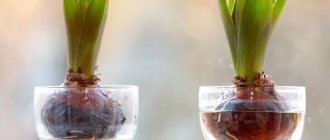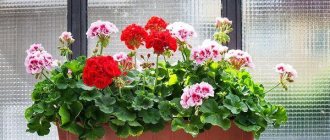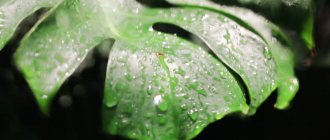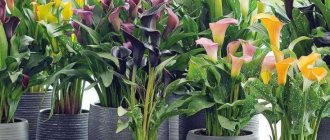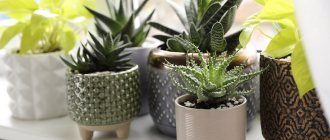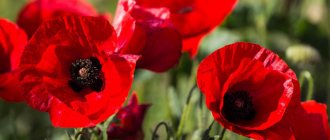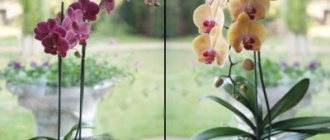Aloe
An unpretentious house plant that brings great benefits. The list of medicinal properties of aloe is large: from healing abrasions and burns to strengthening the immune system. Experts recommend placing aloe in the room of people suffering from asthma.
The plant is absolutely safe for allergy sufferers and small children. The edges of the fleshy leaves are framed by a number of soft spines that are not capable of causing serious damage, and the juice of the leaves is harmless. What is especially important if a child breaks off a plant while playing.
Aloe does not like direct sunlight, so choose a bright place without bright lighting.
Dust collecting on the leaves can pose a danger to allergy sufferers. Therefore, they need to be wiped regularly.
Dangerous for health
Oddly enough, the worst enemies of an allergy sufferer are not plants at all. What would you think?
Enemy number 1 . Regular house dust. It settles on the leaves, especially if they are rarely wiped. A dust allergy can be perceived as a plant allergy. In the vast majority of cases, dust allergies manifest as a runny nose or conjunctivitis. To prevent this, try wiping the leaves, and if wiping is difficult or impossible, then bathe the plants in the shower at least once every six months.
Enemy number 2 . Tobacco smoke. Of course, plants don't smoke. But components of tobacco smoke can accumulate near smoking areas on thick or pubescent leaves. Of course, they will not cause allergies in smokers, but other people may suffer from it. The control measures are the same - periodically wash the plants, and also stop smoking.
Croton
The spectacular croton with carved colored leaves is also safe if you have allergies. Its glossy leaves do not attract dust, and the low need for watering prevents mold from developing in the soil.
The plant requires care and the slightest disturbance affects its appearance. Croton grows in the form of a tree or bush.
In a children's room it is better to keep it on the windowsill, and in large rooms it grows well in a floor planter.
Safety precautions
Remember, even if a plant does not cause allergies, it can still be harmful to keep indoors. Representatives of this class are often found in bouquets. So, a sprig of wild rosemary or bird cherry can give you a headache for the whole day. If you have little understanding of botany, following a general rule will help - be careful with bouquets of flowers with a strong scent and never place them in the bedroom.
What to give to a friend or relative if he is both a flower lover and an allergy sufferer rolled into one? The good news is that some plants almost never cause allergies. These, for example, include orchids and bromeliads, fortunately there are a lot of them in stores now, and the flowers are very bright and unusual. The pollen of these plants does not disperse into the air and you can be calm about your own and others’ health.
So feel free to give an allergic person Phalaenopsis, Vriesia, Guzmania, Cambria or any other representative of these families. Of the common store-bought options, double rose or begonia are perfect. What if you like some unfamiliar flower?
Remember the rule: allergies are mainly caused by pollen. If there is no pollen, then there is no allergy. Any double flowers produce virtually no pollen, since additional petals usually lead to the disappearance or greatly reduced number of stamens. Therefore, among the two plants, it is better to choose the one that blooms with double flowers.
And the second note: allergies to pollen and dust are much less likely if the air is humid. Plants usually like it too, so spraying will bring double benefits, especially during the dry winter period.
You should also not be afraid of various chemicals intended for treatment against pests and diseases. They usually do not cause allergies. However, remember: they are poisonous. Be sure to follow all necessary personal safety precautions.
| Name | What dangers await |
| Pelargonium (geranium) | Lots of essential oils that can trigger asthma attacks in some people |
| Eucharis, Crinum, Hippeastrum | Possible pollen allergy |
| Gerbera | Produces a lot of pollen, which can cause allergies |
| Kalanchoe | It is possible to be allergic to both flower pollen and plant sap |
| Oleander, some heathers (rhododendrons) | May cause non-allergic headaches |
| Dieffenbachia, most milkweeds | Caustic sap that causes symptoms of hives if it comes into contact with hands. Moreover, even the healthiest people suffer from it, and not just allergy sufferers |
| Some types of cacti | Easily broken off spines that dig into the skin. Getting them is not a trivial task: very often the tips of the spines break off and inflammation begins, accompanied by severe itching. The most insidious plant in this regard is prickly pear. Groups of its small and extremely tenacious spines (even given a special name - glochidia) look like fluffy halos and, if you stroke them unknowingly, you are doomed to pull out the spines over the next few days. The prickly pear spines are very small, no more than 2 mm in length, and fall off easily, so you can stumble upon them by accident or even inhale them. |
Peperomia
Peperomia will be an assistant in maintaining and restoring health. It has the properties of purifying the air from microorganisms that cause diseases and allergens.
The plant is compact and very decorative. The advantages are low maintenance requirements. Peperomia can grow and even bloom in the shade, and it is watered when the soil becomes completely dry.
Begonia
Begonia loves a bright place and abundant watering. Its large, fleshy greens act as a filter that cleans the air of dust and bacteria. And the essential oils released by the plant have a beneficial effect on the respiratory tract.
Unlike other pubescent plants, begonia is not dangerous for allergies and for children. Its hairs do not fall off and have a soft structure, without hooks at the end.
Causes of allergies to flowers
Doctors identify two main causes of allergies to flowering plants:
- Pollen entering the body settles on the mucous membrane of the upper respiratory tract and causes irritation. In this case, pollen elements must have the so-called “permeability factor,” that is, pass through the epithelial ball and disrupt the protective functions of the mucous membrane of the upper respiratory tract.
- Activation of the reagin mechanism in allergies: pollen enters the body and causes a reaction of immunoglobulins E and G, and also increases the amount of serotonin and histamine in the blood.
To understand whether there is an allergy to flowers (or rather, their pollen during flowering), it is worth knowing exactly how it manifests itself, that is, the symptoms of an allergic reaction in the body. The most pronounced include:
- tearfulness;
- skin itching;
- dry cough;
- runny nose;
- sneezing;
- swelling of the eyelids and nose;
- conjunctivitis.
In the most severe cases, symptoms can be more serious, including angioedema and bronchial asthma. Please note: in some cases, a severe allergic reaction to flowers can cause increased sensitivity to other common allergens, such as household dust or pet dander. It is important to understand that any allergy, including to flowers, cannot be treated - you can only relieve its symptoms with the help of certain medications and avoid contact with allergens. To accurately determine such substances, you should contact a laboratory to carry out special skin tests (it is recommended to undergo this procedure between November and March, when there are no flowering plants outside). During the manipulation, shallow scratches are made on the skin, onto which allergen concentrates are dripped, observing the patient’s reaction.
Phalaenopsis Orchid
This plant cannot cause allergies due to its biological characteristics. The fact is that in orchids, pollen, which is the main cause of attacks, does not rise into the air. It sticks together into lines that can only be carried by insects.
The only way to get pollen into your respiratory tract is to smell the flower or touch it with your hands and then rub your nose.
The orchid is capricious and demanding in terms of lighting and soil composition. People suffering from allergies should change the soil frequently, as the bark that is part of it begins to decompose and release harmful substances.
The plant is absolutely safe in a room with children.
Choosing Hypoallergenic Flowers Wisely
How pleasant it is to contemplate lush greenery in summer cottages, homes, offices, hospitals and educational institutions. Living cultures carefully filter the air, filling it with oxygen. In addition, they calm the human nervous system and emphasize the design of the garden and room. However, you should not choose crops only by appearance; it is important to consider the degree of influence on the body.
Plants for indoor spaces
Let's look at the most popular indoor flowers for allergy sufferers that can be used to decorate your living space:
- Chlorophytum crested;
- dracaena;
- aloe;
- lemon Tree;
- large-flowered pelargonium;
- nephrolepis;
- all types of begonia;
- violets;
- spathiphyllum.
Of course, there are many more than on this list. The main thing is that they exist. Therefore, people who are allergic to flowering plants can also create lush plantings in their home.
You cannot grow many flowering crops in the bedroom. When pots are frequently moistened, fungi appear in pots that are hazardous to health.
Creating a safe garden
Some fans of ornamental plants in their summer cottages also encountered a similar problem. Popular flowers that decorate flower beds cause allergies in many people.
These include:
- lilies;
- lilies of the valley;
- asters;
- chrysanthemums;
- daisies;
- marigold;
- calendula.
During flowering, they release pollen, which settles on the mucous membrane, causing illness. In addition, allergies are caused by small elements of plants: scales, hairs, pubescent foliage and stems. Even pieces of greenery from trimmed shrubs and lawns have a detrimental effect on the condition of sensitive people. Is it possible to create a garden for allergy sufferers that does not contain “dangerous” plants? Fortunately, there is a way out. The main thing is to choose your crops wisely and learn a few rules.
First of all, there should be no drafts on the site. To reduce pollen volatility, an additional reservoir is installed. The territory of a country house is surrounded by a high fence or hedge of forest trees.
Ground cover crops are used to cover lawns:
- moss;
- creeping speedwell;
- tenacious;
- mazus.
Various types of succulents do not cause allergies because they produce a tiny amount of pollen. A lush carpet is made from periwinkle or white clover. Ferns, heuchera and awl-shaped phlox are suitable.
Of course, you need to constantly ensure that allergy-causing weeds do not enter the garden, such as:
- meadow fescue;
- wheatgrass;
- sagebrush;
- quinoa;
- dandelion.
Particular attention should be paid to choosing garden flowers for allergy sufferers that do not irritate the mucous membranes. Fortunately, there are a huge number of them, both annual and perennial options. They will delight your heart throughout the season.
The following can be safely grown in flower beds:
- crocuses;
- irises;
- pansies;
- snowdrops;
- forget-me-nots;
- petunia;
- poppies;
- delphinium.
Some herbs that have a specific aroma do not cause problems. Sage, mint, rosemary and lavender will fit into the landscape. As you can see, correctly selected hypoallergenic flowers bring invaluable benefits to flora fans. In such an environment it is easy to relax, recharge your batteries and breathe fresh air. The main thing is to approach the matter wisely when choosing suitable plants.
Spathiphyllum
A charming plant with large leaves and delicate white flowers. Spathiphyllum purifies and moisturizes the air, saturates it with oxygen.
Flower care is minimal: regularly water and wipe the leaves.
The plant is popularly called the “flower of happiness”; it is believed to lift the spirits. Therefore, it is especially recommended for growing in a children's room. The flower does not contain any harmful substances, so you don’t have to worry about your child accidentally biting off a leaf.
Selecting houseplants responsibly will help you create an allergy-safe mini-garden. And the presence of flowers in the children's room will help create a favorable atmosphere and teach the child responsibility.
“Unsafe” and prohibited flowers for allergy sufferers
In medicine, there are about 7,000 species of flowers and about 11,000 species of flowering plants to which a person may be allergic. Moreover, in some countries there are even “floristic maps” showing the periods and areas of flowering of plants that cause allergies. The most famous allergic flowers and plants include:
- Cereals (rice, alfalfa, rye, wheat) that can cause cross-allergy to pollen from other plants.
- Ambrosia wormwood (weed) - its flowering can cause very severe allergies: with a concentration of only 25 pollen grains per 1 m³ of atmospheric air, there is a high probability of moderate hay fever (rhinoconjunctivitis).
- Flowers from the Astrov genus - sunflowers, dandelions, daisies, coltsfoot, common chamomile (not only its flowers, but also its leaves can cause allergies).
- Plants with a strong aroma, especially lilies and bird cherry during the flowering period.
- Some indoor plants, due to the distribution of essential oils, can also cause allergies - for example, geranium (pelargonium). If geranium essential oils come into contact with the mucous membrane of the respiratory organs, an allergic person may experience swelling, itching and severe coughing attacks.
It is worth remembering this list when choosing a bouquet not only for an allergy sufferer, but also for discharge from the maternity hospital - it is especially contraindicated to present strong-smelling plants to a young mother and baby that can easily provoke an allergic reaction in the baby.

